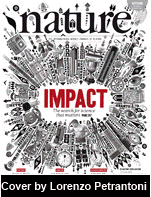|
|
|
|
|
|
|
News & Views item - October 2013 |
![]() Nature Puts Impact Under the Microscope.
(October 18, 2013)
Nature Puts Impact Under the Microscope.
(October 18, 2013)
 Every
research funding agency wants to support science that makes a difference, but
there is no simple formula for identifying truly important research. And as
funding gets squeezed, scientists face ever-stiffer competition for resources
and jobs, and it becomes even more important to identify the best work. In a
series of features and opinion pieces in this issue, we examine how the impact
of research is measured — and ask whether today’s evaluation systems promote the
most influential science.
Every
research funding agency wants to support science that makes a difference, but
there is no simple formula for identifying truly important research. And as
funding gets squeezed, scientists face ever-stiffer competition for resources
and jobs, and it becomes even more important to identify the best work. In a
series of features and opinion pieces in this issue, we examine how the impact
of research is measured — and ask whether today’s evaluation systems promote the
most influential science.
And the journal with the highest impact factor?

Nature's lead editorial for October 16 opens with: "So much science, so little time. Amid an ever-increasing mountain of research articles, data sets and other output, hard-pressed research funders and employers need shortcuts to identify and reward the work that matters. They have plenty of options: research impact is now recognized as a multidimensional affair."
And goes on to echo the the viewpoint now increasingly shared in research circles and summed up recently by the CEO of the NHMRC, Warwick Anderson: "For too long, the reputation of a journal has dominated publication choice – and the reputation has been mainly determined the journal impact factor. This metric reflects how frequently the totality of a journal’s recent papers are cited in other journals."
Of course coming from Nature with its place in the pecking order the viewpoint has, well, a high impact factor.
_________________________________________________
On the other hand the matter of assessing impact of individual research papers based on citation metrics goes on apace.